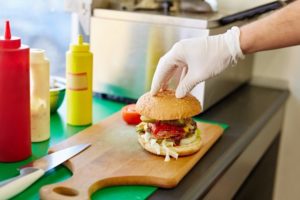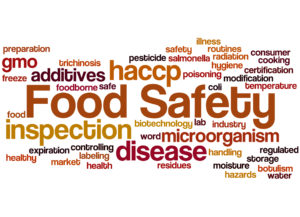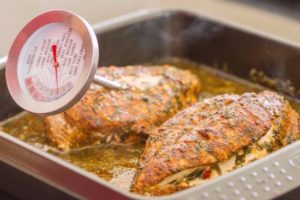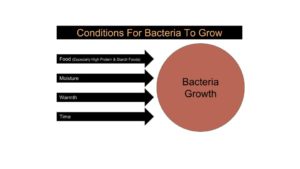 Do you think that ‘Food Safety’ is just for commercial food handlers and germ and hygiene freaks? Or does the idea of preparing food and hosting an event make you break out into a sweat at the thought of a food poisoning fiasco with your family and friends? Food Safety and hygiene for entertaining and parties is a serious issue that every host should be familiar with. However there is no need to freak out about it, by following the basic Food Safety Australia guidelines you can vastly minimise the risks of food contamination.
Do you think that ‘Food Safety’ is just for commercial food handlers and germ and hygiene freaks? Or does the idea of preparing food and hosting an event make you break out into a sweat at the thought of a food poisoning fiasco with your family and friends? Food Safety and hygiene for entertaining and parties is a serious issue that every host should be familiar with. However there is no need to freak out about it, by following the basic Food Safety Australia guidelines you can vastly minimise the risks of food contamination.
What is Food Safety all about? It’s important to be aware that there is more to food safety and hygiene than ensuring your kitchen is clean and you’ve washed your hands. Some food safety guidelines are about washing and sanitising and others are factors that people often don’t consider when preparing, handling and storing foods. How familiar are you with food safety? Can you answer these 4 questions?
 What are core conditions for bacteria to thrive in food?
What are core conditions for bacteria to thrive in food?
What is the food temperature danger zone?
Why is gravy a high risk item for food bacteria?
What are the 4 principles to prevent food poisoning?
Food contamination can be broadly classed as biological, chemical, physical or cross-contamination and can happen through out the food supply chain. Harmful Pathogens can infect food where it’s grown or produced, and during transport, storage, preparation, cooking, serving and every moment in between!
The Food Safety Code (governed by the Food Standards Australia New Zealand, FSANZ) requires businesses handling food to follow safety law and regulations.
In this article, let’s look at your responsibilities and risks when preparing and serving food for an event.
Know The Risks of Bacteria
 Bacteria like certain conditions to thrive. Here are the 4 things they love:
Bacteria like certain conditions to thrive. Here are the 4 things they love:
Food (Especially high protein and starch foods)
Moisture
Warmth
Time
If you stop or prevent one or more of these food bacteria requirements then you’ll stop the growth of bacteria.
When all these components are combined there is a perfect ground for multiplying of harmful bacteria. This is why a hot roast gravy sitting on your serving table can be a prime high-risk target for food poisoning as it meets all the above conditions.
Separate your raw meat, poultry and seafood
Cross-contamination is a key reason for food poisoning incidents. When raw foods come into contact with ready-to-eat foods, cross-contamination can occur. This may sound alarming, but it’s easily avoided. To prevent cross-contamination follow these tips.
Purchasing
Place meat and ready to cook items in separate bags at the shops. Also remember, if you’re not going to cook the meat in the next day or 2, it needs to be put in the freezer. Tip: Use freezer and cooler bags to keep your meats and seafood cold while you’re out shopping.
Preparing
Use a separate chopping board, ideally metal or glass for your meat, poultry and seafood. Also separate cutting utensils for meat and wash all of these thoroughly.
Storing
Do not place meat and ready to eat items on the same shelf in the fridge. Meat, poultry, and seafood should be placed on the bottom shelf to avoid any dripping juices falling down onto other food. Cover meats with wrap or ensure its stored in a sealed container.
Keep Cold And ‘Ready To Eat’ Foods Chilled
- It’s safer to defrost foods in the refrigerator, rather than on the bench.
- Keep perishable foods in the fridge.
- As soon as hot foods stop steaming, place in the fridge, if you’re not keeping it heated.
Cook Food Safely
 Ensure you’re aware of the correct cooking temperatures for your food and equipment to ensure your produce, particularly meat and seafood is cooked safely. If you’re reheating items, heat the food until it’s steaming hot.
Ensure you’re aware of the correct cooking temperatures for your food and equipment to ensure your produce, particularly meat and seafood is cooked safely. If you’re reheating items, heat the food until it’s steaming hot.
Hiring a reputable, accredited catering company will ensure your food is cooked, stored and transported at correct temperatures and conditions to avoid contamination.
Store Food Safely Before & During The Party
Avoid The Food Temperature Danger Zone: 5° to 60°
The danger zone is real, it’s the temperature zone where you food comes under attack from bacteria. The temperature zone 5 to 60 degrees is the ideal breeding ground for bacteria. Food left out on bench tops or serving tables is often susceptible.
5 Tips to Combat The Food Danger Zone
- Plan where you’ll store your food to avoid this risk. Prior to the party starting, keep hot food ready to be served in your oven (not your benchtop) with the oven temperature set to 60° or 100° if that is the lowest it will go.
- Check your fridge. Ensure that your fridge thermometer is at 5 degrees or colder. If a fridge is old, left open lots, or really full the temperature could rise up and into the lower rungs of the ‘danger zone’. Additionally a crowded fridge can can restrict air circulation which can also increase the temperature.
- Keep hot food you are serving hot. To keep appropriately warm you can:
- Place food back in oven set at 60 degrees.
- Use a slow cooker to keep hot food.
- Use warmers and chafing dishes.
- Use a microwavable hot dish to keep foods warm for up to an hour.
- Hire a professional caterer to help you ensure food is kept warm.
- Keep sizes small. Serve up food in smaller serving dishes and keep the rest in the oven/fridge and keep replacing them on your buffet/serving table as you need them. Caterers are also experts at only serving and carving the appropriate sizes.
- Do not consume or serve food that has been in the 5° to 60° temperature danger zone for 4 or more hours. 1- 4 maximum. Ideally food should be consumed within 2 hours of food being at room temperature.
4 Tips To Prevent Food Poisoning
- Clean
- Cook
- Chill
- Separate
Party Food Safety Checklist
- Separate meat/poultry/seafood and other foods when preparing and storing in the fridge.
- Clean surfaces and equipment thoroughly between cooking and preparing tasks.
- Avoid loose clothing and remove jewellery.
- Keep food chilled in the fridge if it’s not being served.
- Keep hot food heated above 60 degrees.
- Portion Control. Distribute food into smaller dishes and containers and keep in the fridge til you need them.
- Ensure food being prepared or served does not enter the danger zone: 5° to 60°.
- Use warm to hot water for cleaning 54- 60 degrees.
- Consider using reputable suppliers and caterers to ensure all Australian food regulations, standards and food safety best practices are followed for your event.
By planning and following these food safety best guidelines you can easily ensure food at your event is safely handled and enjoyed.
Then, of course, that there’s also the risk of double dipping guests : )

